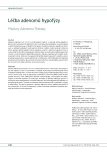The Impact of Functional Mapping on the Results of Low-grade – WHO Grade II - Glioma Surgery
Authors:
R. Bartoš 1; P. Vachata 1; A. Hejčl 1; A. Zolal 1; A. Malucelli 1; T. Radovnický 1; M. Posltová 2; F. Cihlář 3; M. Derner 3; M. Sameš 1
Authors‘ workplace:
Neurochirurgická klinika UJEP a Krajská zdravotní a. s., Masarykova nemocnice v Ústí nad Labem, o. z.
1; Histopatologická laboratoř Biolab, Praha
2; Radiologické odd., Krajská zdravotní a. s., Masarykova nemocnice v Ústí nad Labem, o. z.
3
Published in:
Cesk Slov Neurol N 2011; 74/107(3): 292-298
Category:
Original Paper
Overview
Low-grade glioma WHO II is an intrinsic tumour of the young and middle-aged, often well-differentiated, in certain cases with a favourable long-term prognosis. At the same time, its microsurgical differentiation from healthy and potentially highly functional brain tissue often proves difficult. Thus, use of functional mapping methods during surgery becomes essential. This article evaluates the clinical results of 40 low-grade surgical procedures in 35 patients, with particular reference to the evaluation of epilepsy compensation and return to accustomed employment. How radical the resection has been is certainly one of the factors most involved in a favourable prognosis; this is evaluated by means of computer-aided semiautomatic volumetry. In this contribution we also focus on the feasibility of meaningful resection in relation to individual functional areas of the brain.
Key words:
low-grade glioma – epilepsy – resection radicality – volumetry – functional mapping
Sources
1. Engel J jr. Outcome with respect to epileptic seizures. In: Engel Engel J jr (ed). Surgical Treatment of the Epilepsies. New York: Raven Press 1987 : 553–571.
2. Keles GE, Lamborn KR, Berger MS. Low-grade hemisferic gliomas in adults: a critical review of extent of resection as a factor influencing outcome. J Neurosurg 2001; 95(5): 735–745.
3. Scerrati M, Rosselli R, Iacoangeli M, Pompucci A, Rossi GF. Prognostic factors in low grade (WHO grade II) gliomas of the cerebral hemispheres: the role of surgery. J Neurol Neurosurg Psychiatry 1996; 61(3): 291–296.
4. Nicolato A, Gerosa MA, Fina P, Iuzzolino P, Giorgiutti F, Bricolo A. Prognostic factors in low-grade supratentorial astrocytomas: a uni-multivariate statistical analysis in 76 surgically treated adult patients. Surg Neurol 1995; 44(3): 208–223.
5. van Veelen MC, Avezaat CJ, Kros JM, van Putten W, Vecht C. Supratentorial low grade astrocytoma: prognostic factors, dediferentiation, and the issue of early versus late surgery. J Neurol Neurosurg Psychiatry 1998; 64(5): 581–587.
6. Laws ER, Taylor WF, Clifton MB, Okazaki H. Neurosurgical management of low-grade astrocytoma of the cerebral hemispheres. J Neurosurg 1984; 61(4): 665–673.
7. Piepmeier JM. Observations on the current treatment of low-grade astrocytic tumors of the cerebral hemispheres. J Neurosurg 1987; 67(2): 177–181.
8. Bartoš R, Sameš M, Julišová I, Derner M, Hladíková M. Supratentoriální gliom WHO grade II. Retrospektivní studie 37 pacientů. Cesk Slov Neurol N 2003; 66/99(5): 355–360.
9. Piepmeier J, Christopher S, Spencer D, Byrne T, Kim J, Knisel JP et al. Variations in the natural history and survival of patients with supratentorial low-grade astrocytomas. Neurosurgery 1996; 38(5): 872–879.
10. Chaichana KL, McGirt MJ, Laterra J, Olivi A, Quiñones-Hinojosa A. Recurrence and malignant degeneration after resection of adult hemispheric low-grade gliomas. J Neurosurg 2010; 112(1): 10–17.
11. Ahmadi R, Dictus C, Hartmann C, Zürn O, Edler L et al. Long-term outcome and survival of surgically treated supratentorial low-grade glioma in adult patients. Acta Neurochir 2009; 151 : 1359–1365.
12. Peraud A, Ansari H, Biste K, Reulen H. Clinical outcome of suprratentorial astrocytoma WHO grade II. Acta Neurochir (Wien) 1998; 140(12): 1213–1222.
13. Krouwer HG, Davis RL, Silver P, Prados M. Gemistocytic astrocytomas: A reappraisal. J Neurosurg 1991; 74(3): 339–406.
14. Sanai N, Polley MY, Berger M. Insular glioma resection: assessment of patient morbidity, survival, and tumor progression. J Neurosurg 2010; 112(1): 1–9.
15. Duffau H, Khalil I, Gatignol P, Denvil D, Capelle L. Surgical removal of corpus callosum infiltrated by low-grade glioma: functional outcome and oncological considerations. J Neurosurg 2004; 100(3): 431–437.
16. Berger MS, Deliganis AV, Dobbins J, Keles GE. The effect of extent of resection on recurrence in patients with low grade cerebral hemisphere gliomas. Cancer 1994; 74(6): 1784–1790.
17. Chang EF, Potts MB, Keles GE, Lamborn KR, Chang SM, Barbaro NM, Berger MS. Seizure charakteristics and control following resection in 332 patients with low-grade gliomas. J Neurosurg 2008; 108(2): 227–235.
Labels
Paediatric neurology Neurosurgery NeurologyArticle was published in
Czech and Slovak Neurology and Neurosurgery

2011 Issue 3
Most read in this issue
- Pituitary Adenoma Therapy
- Limbic Encephalitis – Two Case Reports
- A patient in Persistent Vegetative State and his Rehabilitation
- Mild Brain Injury – Intracranial Complications and Indication Criteria for CT Imaging
